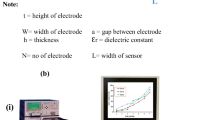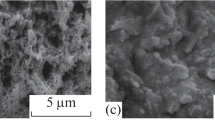Abstract
The instability of enzymatic glucose sensors has prevented the development of a practical artificial pancreas for diabetic patients. We therefore developed an enzyme-free glucose sensor using the gate effect of a molecularly imprinted polymer (MIP). This sensor has the advantages of improved stability and a simplified manufacturing procedure. An adduct of glucose and 4-vinylphenylboronic acid (VPBA) was synthesized by esterification and was then purified. The copolymer of the glucose/VPBA adduct and methylene bisacrylamide was grafted onto an indium tin oxide electrode surface. Glucose was washed out from the copolymer to obtain an MIP layer. Cyclic voltammetry of ferrocyanide in aqueous solution was performed using an MIP-grafted electrode, and the effect of glucose on the anodic current intensity was evaluated. The anodic current intensity was sensitive to the glucose concentration, and the dynamic range (0–900 mg/dl) covered the typical range of diabetic blood glucose levels. The response time of the MIP-grafted electrode to a stepwise change in the glucose concentration was approximately 3–5 min. Thus, we can conclude that, by taking advantage of its gate effect, it is feasible to use an MIP-grafted electrode as a glucose sensor for monitoring blood sugar in diabetic patients.
Similar content being viewed by others
References
Unwin N, Marlin A. Diabetes action now: WHO and IDF working together to raise awareness worldwide. Diabetes Voice 2004;49: 27–31
Shichiri M, Yamazaki Y, Kawamori R, Hakui N, Abe H. Wearable artificial endocrine pancreas with needle-type glucose sensor. Lancet 1982;320: 1129–1131
Shichiri M, Kishikawa H, Sakakida M, Kajiwara K, Hashiguchi Y, Nishida K, Uemura T, Konno Y, Ichinose K. Artificial endocrine pancreas and optimal blood glucose regulation in diabetic patients — from bedside type to wearable type. Diabetes Res Clin Pract 1994;24: S251–S259
Mastrototaro JJ, Cooper K, Shah R. Early clinical experience with an integrated continuous glucose sensor insulin pump platform. Diabetes Res Clin Pract 2006;74: S156–S159
Ramström O, Yan M. Molecular imprinting — an introduction. In: Yan M, Ramström O (eds) Molecularly imprinted materials. New York: Marcel Dekker 2005;1–12
Haupt K. Molecularly imprinted polymers as recognition elements in sensors: mass and electrochemical sensors. In: Yan M, Ramström O (eds) Molecularly imprinted materials. New York: Marcel Dekker 2005;685–700
Vlatakis G, Andersson LI, Müller R, Mosbach K. Drug assay using antibody mimics made by molecular imprinting. Nature 1993;361: 645–647
Ulbricht M. Membrane separation using molecularly imprinted polymers. J Chromatogr B 2004;804: 113–125
Sellergren B. Imprinted chiral stationary phase in high-performance liquid chromatography. J Chromatogr A 2001;906: 227–252
Piletsky SA, Piletskaya EV, Elgersma AV, Yano K, Karube I, Parhometz YP, El’skaya AV. Atrazine sensing by molecularly imprinted membranes. Biosens Bioelectron 1995;10: 959–964
Piletsky SA, Piletskaya EV, Panasyuk TL, El’skaya AV, Levi R, Karube I, Wulff G. Imprinted membranes for sensor technology: opposite behavior of covalently and noncovalently imprinted membranes. Macromolecules 1998;31: 2137–2140
Sergeyeva TA, Piletsky SA, Brovko AA, Slinchenko LA, Sergeeva LM, Panasyuk TL, El’skaya AV. Conductometric sensor for atrazine detection based on molecularly imprinted polymer membrane. Analyst 1999;124: 331–334
Sergeyeva TA, Piletsky SA, Brovko AA, Slinchenko LA, Sergeeva LM, El’skaya AV. Selective recognition of atrazine detection by molecularly imprinted polymer membranes. Development of conductometric sensor for herbicides detection. Anal Chim Acta 1999;392: 105–111
Yoshimi Y, Ohdaira R, Iiyama C, Sakai K. “Gate effect” of thin layer of molecularly-imprinted poly(methacrylic acid-coethyleneglycol dimethacrylate). Sens Actuators B Chem 2001;73: 49–53
Sekine S, Watanabe Y, Yoshimi Y, Hattori K, Sakai K. Influences of solvents on chiral discriminative gate effect of molecularly imprinted poly(ethyleneglycol dimethacrylate-co-methacrylic acid). Sens Actuators B Chem 2007;127: 512–517
Piletsky SA, Piletskaya EV, Yano K, Kugimiya A, Elgersma AV, Levi R, Kahlow U, Takeuchi T, Karube I. A biomimetic receptor system for sialic acid based on molecular imprinting. Anal Lett 1996;29: 157–170
Hattori K, Yoshimi Y, Sakai K. Gate effect of cellulosic dialysis membrane grafted with molecularly imprinted polymer. J Chem Eng Jpn 2001;34: 1466–1469
Hattori K, Yoshimi Y, Ito T, Hirano K, Kohori F, Sakai K. Effect of electrostatic interactions on gate effect in molecularly imprinted polymers. Electrochemistry 2004;72: 508–516
Hattori K, Hiwatari M, Iiyama C, Yoshimi Y, Kohori F, Sakai K, Piletsky SA. Gate effect of theophylline-imprinted polymers grafted to the cellulose by living radical polymerization. J Membr Sci 2004;233: 169–173
Wulff G. Selective binding to polymers via covalent bonds. The construction of chiral cavities as specific receptor sites. Pure Appl Chem 1982;54: 2093–2102
Springsteen G, Wang B. A detailed examination of boronic acid-diol complexation. Tetrahedron 2002;58: 5291–5300
Wulff G, Biffis A. Molecular imprinting with covalent or stoichiometric noncovalent interactions. In: Sellergren B (ed) Molecularly imprinted polymers: man-made mimics of antibodies and their applications in analytical chemistry. Amsterdam: Elsevier 2001;71–111
Kugimiya A, Yoneyama H, Takeuchi T. Sialic acid imprinted polymer-coated quartz crystal microbalance. Electroanalysis 2000;12: 1322–1326
Bard AJ, Faulkner LR. Electrochemical methods: fundamentals and applications, 2nd edn. New York: Wiley 2001;226–260
Yoshimi Y, Haramoto H, Miyasaka T, Sakai K. Cathodic electrochemiluminescence of luminol enhanced by antibody-antigen reaction. J Chem Eng Jpn 1996;29: 851–857
Iwata H, Matsuda T. ESCA — Surface analysis (I). In: Ikada Y (ed) Fundamental and Application of Polymer Surface (I). Kyoto: Kagaku Doujin 1986;89 (in Japanese)
American Diabetes Association Home Page, http://www.diabetes.org/about-diabetes.jsp. Accessed October 1, 2009
Shapiro ET, Tillil H, Polonsky KS, Fang VS, Rubenstein AH, Van Cauter E. Oscillations in insulin secretion during constant glucose infusion in normal man: relationship to changes in plasma glucose. J Clin Endocrinol Metab 1988;67: 307–314
Author information
Authors and Affiliations
Corresponding author
Rights and permissions
About this article
Cite this article
Yoshimi, Y., Narimatsu, A., Nakayama, K. et al. Development of an enzyme-free glucose sensor using the gate effect of a molecularly imprinted polymer. J Artif Organs 12, 264–270 (2009). https://doi.org/10.1007/s10047-009-0473-4
Received:
Accepted:
Published:
Issue Date:
DOI: https://doi.org/10.1007/s10047-009-0473-4




